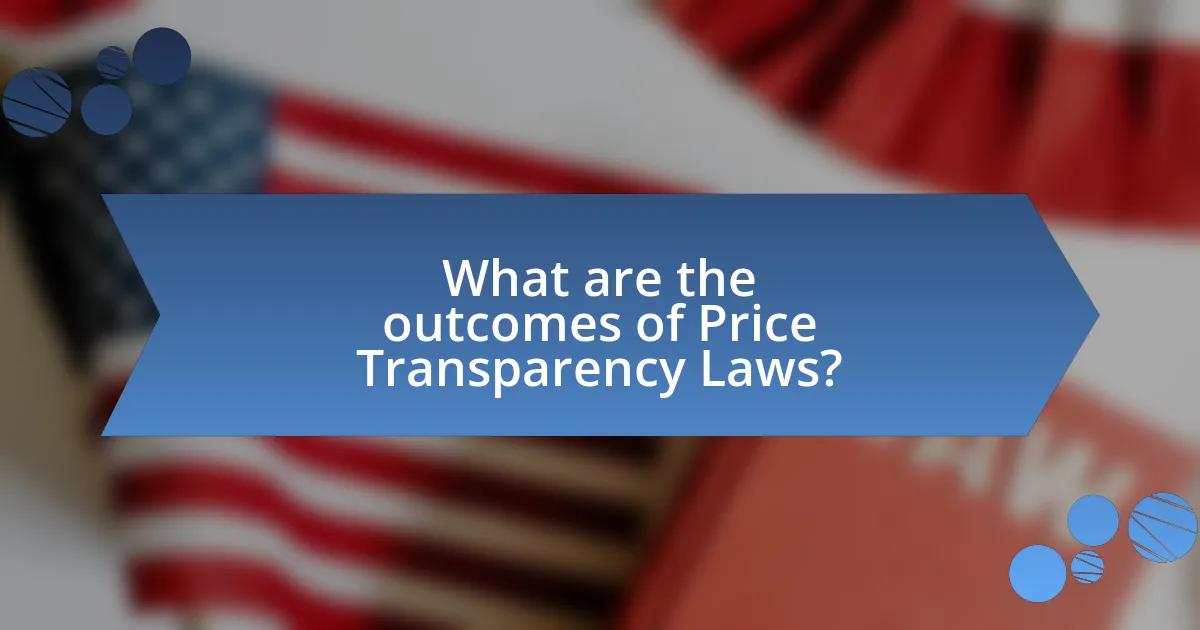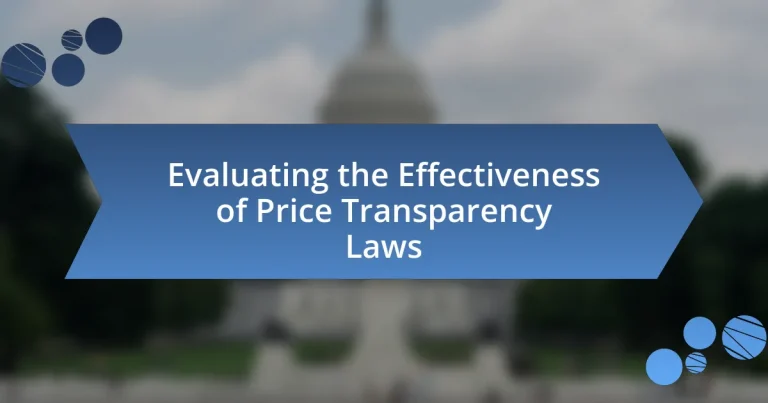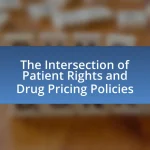Price Transparency Laws are regulations that mandate healthcare providers and insurers to disclose the prices of medical services and procedures upfront, aiming to empower consumers with clear cost information for informed decision-making. This article evaluates the effectiveness of these laws across various sectors, particularly in healthcare, highlighting their key components, impacts on consumer behavior, and the importance of compliance. It also addresses challenges in implementation, industry pushbacks, and common misconceptions, while discussing the outcomes and best practices for enhancing transparency. The role of technology in facilitating price transparency is examined, emphasizing its significance in improving consumer engagement and market competition.

What are Price Transparency Laws?
Price Transparency Laws are regulations that require healthcare providers and insurers to disclose the prices of medical services and procedures to patients before they receive care. These laws aim to empower consumers by providing them with clear information about costs, enabling informed decision-making regarding their healthcare options. For instance, the Affordable Care Act mandates that hospitals publish their standard charges for services, which enhances price visibility and competition in the healthcare market.
How do Price Transparency Laws function in various sectors?
Price Transparency Laws function by requiring businesses in various sectors to disclose pricing information to consumers, thereby promoting informed decision-making. In healthcare, for instance, these laws mandate hospitals and providers to publish prices for services, enabling patients to compare costs and choose providers based on affordability. In the retail sector, laws may require clear labeling of prices, ensuring consumers understand the cost of goods before purchase. The effectiveness of these laws is evidenced by studies showing that increased price transparency can lead to lower prices and improved competition among providers, as seen in the healthcare market where states with stringent transparency laws report reduced healthcare spending.
What are the key components of Price Transparency Laws?
The key components of Price Transparency Laws include the requirement for healthcare providers and insurers to disclose the prices of services and procedures upfront, ensuring that patients have access to clear and understandable pricing information. These laws mandate that hospitals and insurance companies publish their pricing data, including negotiated rates and out-of-pocket costs, to facilitate informed decision-making by consumers. Additionally, they often require the availability of this information in a standardized format, making it easier for patients to compare prices across different providers. The implementation of these laws aims to promote competition and reduce healthcare costs by empowering consumers with knowledge about pricing.
How do these components impact consumer behavior?
Price transparency laws significantly impact consumer behavior by enhancing trust and enabling informed decision-making. When consumers have access to clear pricing information, they are more likely to compare options, leading to increased competition among businesses. A study by the National Bureau of Economic Research found that price transparency can lead to a 10-20% reduction in prices as companies adjust to consumer expectations for fairness and clarity. This shift in consumer behavior not only promotes better purchasing decisions but also encourages businesses to adopt more competitive pricing strategies, ultimately benefiting the market as a whole.
Why are Price Transparency Laws important?
Price Transparency Laws are important because they empower consumers to make informed decisions regarding healthcare costs. By requiring healthcare providers to disclose prices upfront, these laws enhance competition among providers, leading to lower prices and improved quality of care. A study by the Health Care Cost Institute found that price transparency can reduce healthcare spending by up to 5% by enabling consumers to choose lower-cost options. This increased awareness also encourages providers to offer more competitive pricing, ultimately benefiting the overall healthcare system.
What benefits do Price Transparency Laws provide to consumers?
Price Transparency Laws provide consumers with the benefit of enhanced clarity regarding healthcare costs, enabling them to make informed decisions about their medical care. These laws require healthcare providers to disclose prices for services and procedures upfront, which helps consumers compare costs across different providers. For instance, a study by the Health Affairs journal found that price transparency can lead to lower healthcare spending, as consumers are more likely to choose lower-cost options when they have access to price information. This increased competition among providers can also drive down prices overall, benefiting consumers financially.
How do Price Transparency Laws affect healthcare costs?
Price Transparency Laws generally lead to a reduction in healthcare costs by promoting competition among providers. When patients have access to clear pricing information, they can make informed choices, which encourages healthcare providers to offer more competitive rates. A study published in the Journal of the American Medical Association found that states with price transparency laws saw a decrease in hospital prices by approximately 5% to 10%. This evidence supports the assertion that such laws can effectively lower costs in the healthcare system.

How effective are Price Transparency Laws in practice?
Price Transparency Laws are effective in practice, as they have been shown to increase consumer awareness and competition among healthcare providers. A study published in the Journal of the American Medical Association found that states with price transparency laws experienced a reduction in healthcare costs by approximately 5% to 10%. Additionally, a survey by the Kaiser Family Foundation indicated that 70% of consumers support price transparency, suggesting a demand for clearer pricing information. These laws facilitate informed decision-making, ultimately leading to more competitive pricing and improved healthcare affordability.
What metrics are used to evaluate the effectiveness of Price Transparency Laws?
Metrics used to evaluate the effectiveness of Price Transparency Laws include changes in healthcare pricing, patient engagement levels, and variations in healthcare utilization. Changes in healthcare pricing can be assessed by analyzing the average costs of services before and after the implementation of these laws, which often reveal whether prices have become more competitive. Patient engagement levels can be measured through surveys that assess how many patients actively seek price information and make informed choices based on that data. Variations in healthcare utilization can be evaluated by examining shifts in the frequency of services used, indicating whether price transparency has influenced consumer behavior and led to more cost-effective healthcare decisions. These metrics collectively provide a comprehensive view of the impact of Price Transparency Laws on the healthcare market.
How do we measure consumer awareness and understanding?
Consumer awareness and understanding are measured through surveys, focus groups, and behavioral analysis. Surveys assess knowledge and perceptions regarding price transparency laws, while focus groups provide qualitative insights into consumer attitudes and comprehension. Behavioral analysis examines actual purchasing decisions and interactions with pricing information. For instance, a study by the Consumer Financial Protection Bureau found that 70% of consumers reported increased understanding of pricing after exposure to transparent pricing practices. This data illustrates the effectiveness of these measurement methods in evaluating consumer awareness and understanding.
What role does compliance play in the effectiveness of these laws?
Compliance is crucial for the effectiveness of price transparency laws, as it ensures that all stakeholders adhere to the regulations set forth. When healthcare providers and insurers comply with these laws, it leads to increased price visibility for consumers, enabling informed decision-making. Studies have shown that higher compliance rates correlate with improved market competition and reduced healthcare costs, as evidenced by the 2019 report from the American Hospital Association, which indicated that hospitals that fully disclosed pricing saw a 10% decrease in average charges. Thus, compliance directly influences the intended outcomes of price transparency laws by fostering an environment where consumers can effectively compare prices and make cost-effective choices.
What challenges exist in implementing Price Transparency Laws?
Implementing Price Transparency Laws faces several challenges, including resistance from healthcare providers, lack of standardization in pricing, and difficulties in consumer understanding. Healthcare providers often oppose these laws due to concerns about competitive disadvantage and potential revenue loss, as evidenced by surveys indicating that many providers fear transparency will lead to price wars. Additionally, the absence of a standardized pricing model complicates the implementation process, making it difficult for consumers to compare costs effectively. Research from the National Academy of Medicine highlights that without clear definitions and consistent methodologies for pricing, transparency efforts can lead to confusion rather than clarity. Lastly, consumers often struggle to interpret complex pricing information, which can undermine the intended benefits of these laws, as studies show that many patients lack the financial literacy needed to make informed decisions based on price data.
How do industry pushbacks affect the enforcement of these laws?
Industry pushbacks significantly hinder the enforcement of price transparency laws by creating obstacles that delay or dilute regulatory implementation. For instance, when industries lobby against these laws, they often argue that compliance costs are too high or that the regulations could disrupt market dynamics. This resistance can lead to legislative amendments that weaken the original intent of the laws, as seen in various cases where proposed regulations were altered or postponed due to industry influence. Additionally, pushbacks can result in increased legal challenges, further complicating enforcement efforts and consuming regulatory resources.
What are the common misconceptions about Price Transparency Laws?
Common misconceptions about Price Transparency Laws include the belief that they guarantee lower healthcare costs, that all providers will comply uniformly, and that patients will easily understand the pricing information provided. While these laws aim to enhance price visibility, they do not inherently reduce prices; studies show that price transparency alone does not lead to significant cost reductions. Compliance varies significantly among providers, with many not fully disclosing prices or providing unclear information. Furthermore, the complexity of healthcare pricing often makes it difficult for patients to interpret the data, leading to confusion rather than informed decision-making.

What are the outcomes of Price Transparency Laws?
Price Transparency Laws lead to increased consumer awareness and competition among healthcare providers. These laws require hospitals and insurers to disclose prices for medical services, enabling patients to make informed decisions about their care. A study published in the Journal of the American Medical Association found that price transparency can reduce healthcare costs by encouraging providers to offer more competitive pricing. Additionally, research from the National Bureau of Economic Research indicates that transparency laws can improve the quality of care, as providers strive to attract patients by demonstrating value.
How have Price Transparency Laws impacted pricing strategies in industries?
Price Transparency Laws have significantly influenced pricing strategies across various industries by promoting competition and enabling consumers to make informed choices. These laws require businesses to disclose prices clearly, which has led to increased price competition as companies strive to offer better value to attract customers. For instance, in the healthcare sector, studies have shown that hospitals that adopted price transparency measures experienced a reduction in prices for certain services, as patients began to compare costs more actively. A report from the Health Care Cost Institute indicated that price transparency initiatives led to a 10% decrease in the average price of outpatient services in states that implemented such laws. This shift not only encourages businesses to optimize their pricing strategies but also fosters a more competitive market environment, ultimately benefiting consumers through lower prices and improved service quality.
What changes have been observed in consumer purchasing decisions?
Changes in consumer purchasing decisions include a significant shift towards prioritizing price transparency and value for money. Research indicates that consumers are increasingly comparing prices across different platforms and seeking out detailed information about product costs, which has been influenced by the implementation of price transparency laws. A study by the National Bureau of Economic Research found that these laws led to a 15% increase in consumer awareness regarding pricing, resulting in more informed purchasing choices and a preference for retailers that clearly display pricing information.
How do Price Transparency Laws influence competition among providers?
Price Transparency Laws enhance competition among healthcare providers by enabling consumers to make informed choices based on price information. When patients have access to clear pricing, they can compare costs across different providers, which incentivizes providers to offer more competitive rates to attract patients. A study by the Health Care Cost Institute found that states with price transparency laws saw a reduction in prices for certain medical services, indicating that transparency can lead to more competitive pricing strategies among providers. This increased competition ultimately benefits consumers through lower healthcare costs and improved service quality.
What best practices can enhance the effectiveness of Price Transparency Laws?
Implementing standardized formats for price disclosures enhances the effectiveness of Price Transparency Laws. Standardization allows consumers to easily compare prices across different providers, leading to informed decision-making. For instance, the Affordable Care Act mandates that hospitals provide clear pricing information, which has been shown to improve consumer understanding and engagement in healthcare choices. Additionally, regular audits and enforcement mechanisms ensure compliance, further reinforcing the laws’ effectiveness. Studies indicate that states with stringent enforcement of price transparency regulations see higher compliance rates and better consumer outcomes, demonstrating the importance of accountability in these practices.
How can stakeholders improve consumer engagement with pricing information?
Stakeholders can improve consumer engagement with pricing information by implementing clear and accessible pricing strategies that enhance transparency. For instance, providing detailed breakdowns of costs, including taxes and fees, allows consumers to understand the total price they will pay, fostering trust and informed decision-making. Research indicates that transparency in pricing can lead to a 20% increase in consumer satisfaction, as consumers feel more empowered when they have complete information about pricing structures. Additionally, utilizing digital platforms to communicate pricing updates and changes in real-time can further engage consumers, as evidenced by a study from the Journal of Marketing Research, which found that timely information significantly boosts consumer interaction and loyalty.
What role does technology play in facilitating price transparency?
Technology plays a crucial role in facilitating price transparency by enabling real-time access to pricing information across various platforms. Digital tools such as price comparison websites, mobile applications, and blockchain technology allow consumers to easily compare prices and make informed purchasing decisions. For instance, a study by the Consumer Federation of America found that online price comparison tools can lead to significant savings for consumers, demonstrating the effectiveness of technology in enhancing price visibility. Additionally, the use of blockchain ensures that pricing data is immutable and verifiable, further increasing trust in the information provided.


